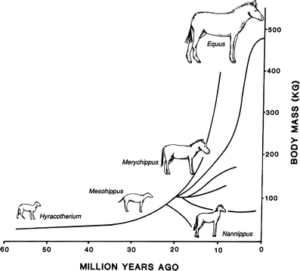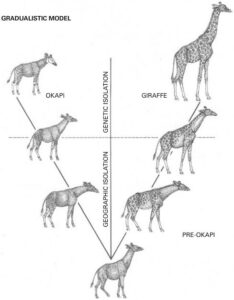Back to: ZOOLOGY 100 Level
Welcome back! Today, we’ll be exploring evolutionary trends, which are patterns of change that occur in species over time. Evolution is a process that shapes all living organisms, and understanding these trends can help us see how life on Earth has adapted and diversified. Let’s get started!

Evolutionary trends
What Are Evolutionary Trends?
Evolutionary trends refer to the general direction or pattern of changes in species or groups of organisms over long periods of time. These trends don’t happen overnight but occur gradually as species adapt to their environments. They can lead to the development of new species, the extinction of old ones, or the appearance of new characteristics that help an organism survive and thrive.

Key Evolutionary Trends
- Adaptation to Environmental Changes
One of the main driving forces behind evolution is adaptation. As environments change (due to factors like climate, geography, or food availability), organisms must adapt to survive. Over generations, these adaptations become common within the population.
- Example: The peppered moth in England is a classic example. During the industrial revolution, the environment became darker due to pollution. Moths with darker coloration were better camouflaged from predators, leading to an increase in the population of dark moths over time.
- Example: The peppered moth in England is a classic example. During the industrial revolution, the environment became darker due to pollution. Moths with darker coloration were better camouflaged from predators, leading to an increase in the population of dark moths over time.
- Increased Complexity
Over time, organisms tend to evolve more complex structures and functions. This complexity can be seen in the development of more advanced body systems, such as the nervous system or the circulatory system, which help organisms survive in complex environments.
- Example: The evolution of the human brain is an example of increased complexity. Over millions of years, the human brain has become larger and more advanced, allowing humans to develop complex social structures, technologies, and cultures.
- Example: The evolution of the human brain is an example of increased complexity. Over millions of years, the human brain has become larger and more advanced, allowing humans to develop complex social structures, technologies, and cultures.
- Specialisation
As species evolve, they may become more specialised in their way of life, often focusing on specific resources or habitats. This can lead to the development of traits or behaviours that allow them to thrive in a particular environment.
- Example: Cactus plants are specialised to survive in desert environments. They have thick, fleshy stems that store water, and spines that help reduce water loss and protect against herbivores.
- Example: Cactus plants are specialised to survive in desert environments. They have thick, fleshy stems that store water, and spines that help reduce water loss and protect against herbivores.
- Reduction or Loss of Unnecessary Features
Sometimes, evolution leads to the loss of certain features that are no longer necessary for survival in a given environment. Over time, these features may become smaller, less functional, or disappear entirely.
- Example: Whales are descended from land mammals, and over time, they have lost their hind limbs. This is an adaptation to life in water, as hind limbs became unnecessary for swimming.
- Example: Whales are descended from land mammals, and over time, they have lost their hind limbs. This is an adaptation to life in water, as hind limbs became unnecessary for swimming.
- Divergence and Speciation
When a population becomes geographically isolated (for example, by a river or mountain range), it may evolve into a separate species. Over time, these isolated groups adapt to their unique environments, leading to speciation, or the formation of new species.
- Example: The Darwin’s finches on the Galápagos Islands are a famous example. Each island had a different type of food, so the finches evolved different beak shapes to access the food on their specific island. Over time, these variations led to the formation of several different species of finches.
- Example: The Darwin’s finches on the Galápagos Islands are a famous example. Each island had a different type of food, so the finches evolved different beak shapes to access the food on their specific island. Over time, these variations led to the formation of several different species of finches.
- Convergence
Sometimes, species from different evolutionary backgrounds develop similar features due to adapting to similar environmental challenges. This is called convergent evolution.
- Example: The wings of bats and birds are an example of convergent evolution. Although bats are mammals and birds are avians, both evolved wings to enable flight, despite their different evolutionary ancestors.

Summary
- Evolutionary trends are patterns of change that happen in species over time, driven by adaptations to environmental changes, increased complexity, and other factors.
- Key trends include adaptation, increased complexity, specialisation, reduction of unnecessary features, divergence, and convergence.
- These trends help species survive in their environments, form new species, or adapt to new challenges.
Evaluation
- What is the main driving force behind evolutionary trends?
- Give an example of a species that evolved due to increased complexity.
- What is speciation, and how does it occur?
- Explain the difference between divergence and convergence in evolution.
- How does specialisation help an organism survive?
You’ve done an amazing job understanding the important evolutionary trends that shape the diversity of life on Earth. Keep up the great work, and I can’t wait to explore more fascinating topics with you!
